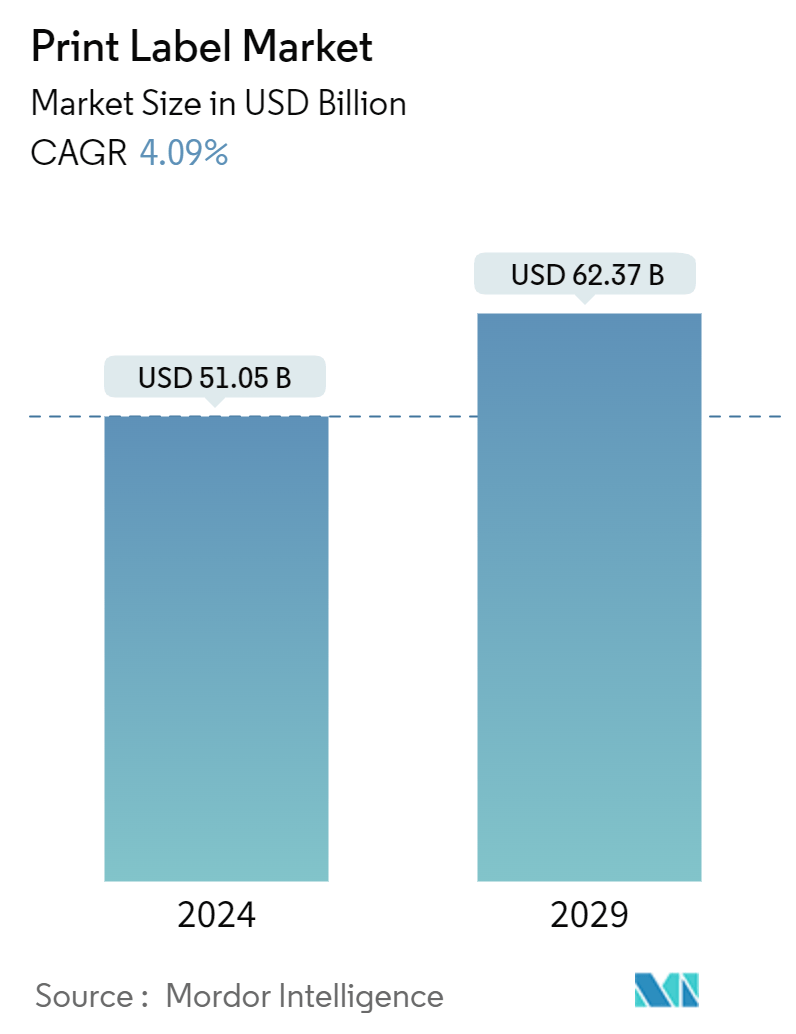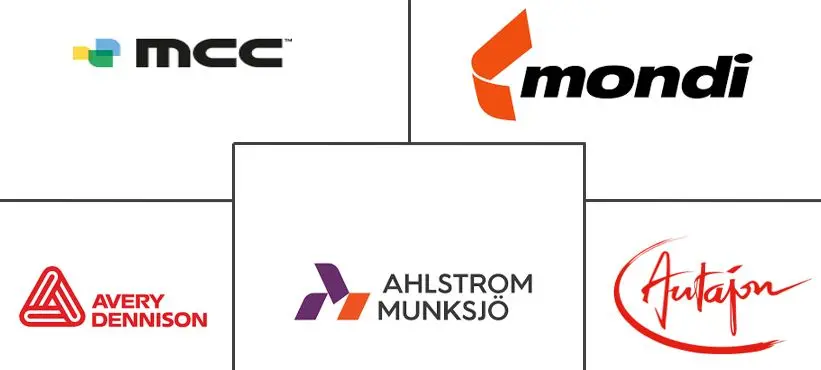Market Size of Print Label Industry

| Study Period | 2022 - 2029 |
| Market Size (2024) | USD 51.05 Billion |
| Market Size (2029) | USD 62.37 Billion |
| CAGR (2024 - 2029) | 4.09 % |
| Fastest Growing Market | Asia Pacific |
| Largest Market | North America |
Major Players
*Disclaimer: Major Players sorted in no particular order |
Print Label Market Analysis
The Print Label Market size is estimated at USD 51.05 billion in 2024, and is expected to reach USD 62.37 billion by 2029, growing at a CAGR of 4.09% during the forecast period (2024-2029).
The print label market is witnessing a surge in demand for more appealing brands. This is fueled by several factors, such as a rise in SKUs, shorter product life cycles, and heightened regulatory requirements on labels. Additionally, as the demand for manufactured goods grows and disposable incomes rise, the print label market is poised for further expansion.
Several key players, including Nilpeter, Xeikon, and Bobst Firenze, assert that digital labels not only meet market demands but also outperform traditional printing methods.
Digital technology has proven adept at meeting diverse industry needs, crafting appealing label designs that entice consumers. While integrating digital tech with existing printing methods promises to revolutionize sectors of all sizes, stringent environmental labeling regulations pose a challenge.
Label application challenges, largely stemming from environmental factors like temperature and humidity, demand careful handling. Labels fare best when applied in dry, room-temperature conditions, although navigating extremes, especially in winter, summer, or cold storage, can be tricky.
Market players are doubling down on sales and distribution channels. For instance, Xeikon's innovation center in Shanghai caters to China's growing needs, offering a platform for testing applications and exploring new revenue streams. Meanwhile, Domino is bolstering its digital printing arm, which is evident in its recent North American service hires.
The pandemic underscored two major hurdles for label companies, i.e., enhancing productivity and providing remote customer support. As demand surged post-pandemic, companies faced capacity strains, emphasizing the urgency of automation across product life cycles.
Print Label Industry Segmentation
A print label, whether paper, plastic, cloth, metal, or another material, is attached to a product or container and bears essential information or symbols about the product. This information can also be directly printed on the container or item. Print labels serve as the key communication channel between a company and its customers. They play a pivotal role in shaping a consumer's perception of a product and in leaving a lasting impression on their minds.
The print label market is segmented by print process (offset lithography, gravure, flexography, screen, letterpress, electrophotography, and inkjet), label format (wet-glue labels, pressure-sensitive labels, linerless labels, multi-part tracking labels, in-mold labels, and shrink and stretch sleeves), end-user industry (food, beverage, healthcare, cosmetics, household, industrial, and logistics), and geography (North America (United States and Canada), Europe (United Kingdom, Germany, France, Spain, Italy, Poland, Netherlands, and Rest of Europe), Asia-Pacific (China, India, Japan, Australia, South Korea, and Rest of Asia-Pacific), Latin America (Brazil, Mexico, and Rest of Latin America), and Middle East and Africa). The market sizes and forecasts are provided in terms of value (USD) for the above segments.
| By Print Process | |
| Offset lithography | |
| Gravure | |
| Flexography | |
| Screen | |
| Letterpress | |
| Electrophotography | |
| Inkjet |
| By Label Format | |
| Wet-glue labels | |
| Pressure-sensitive labels | |
| Linerless labels | |
| Multi-part tracking labels | |
| In-mold labels | |
| Shrink and Stretch Sleeves |
| By End-user Industries | |
| Food | |
| Beverage | |
| Healthcare | |
| Cosmetics | |
| Household | |
| Industrial (Automotive, Industrial Chemicals, and Consumer and Non-consumer Durables) | |
| Logistics | |
| Other End-user Industries |
| Geography | ||||||||||
| ||||||||||
| ||||||||||
| ||||||||||
| ||||||||||
| Middle East and Africa |
Print Label Market Size Summary
The print label market is poised for significant growth over the forecast period, driven by factors such as the increasing number of SKUs, shorter product life cycles, and heightened regulatory requirements. The demand for more visually appealing and informative labels is rising, fueled by the growing consumption of manufactured goods and rising disposable incomes. Digital printing technologies are gaining traction as they offer advantages over traditional methods, meeting the diverse needs of various end-user industries. However, environmental regulations and challenges related to label application in varying environmental conditions pose obstacles to market expansion. Companies are focusing on enhancing their sales and distribution networks, with innovations and investments in digital printing capabilities to cater to evolving market demands.
The food industry is expected to be a major contributor to the print label market, driven by increased consumer awareness and demand for packaged foods that ensure quality and safety. The expansion of modern retail outlets and the rise of e-commerce, particularly in regions like Asia-Pacific, are further propelling market growth. The print label market is highly competitive, with key players engaging in strategic partnerships and acquisitions to strengthen their market presence. Companies are also prioritizing sustainability by adopting environmentally friendly solutions. The market's competitive landscape is characterized by fragmentation, with numerous players striving to capture market share through innovation and expansion efforts.
Print Label Market Size - Table of Contents
-
1. MARKET INSIGHTS
-
1.1 Market Overview
-
1.2 Industry Attractiveness - Porter's Five Forces Analysis
-
1.2.1 Bargaining Power of Suppliers
-
1.2.2 Bargaining Power of Buyers/Consumers
-
1.2.3 Threat of New Entrants
-
1.2.4 Threat of Substitutes
-
1.2.5 Intensity of Competitive Rivalry
-
-
1.3 Industry Value Chain Analysis
-
1.4 Assessment of the Impact of COVID-19 on the Market
-
-
2. MARKET SEGMENTATION
-
2.1 By Print Process
-
2.1.1 Offset lithography
-
2.1.2 Gravure
-
2.1.3 Flexography
-
2.1.4 Screen
-
2.1.5 Letterpress
-
2.1.6 Electrophotography
-
2.1.7 Inkjet
-
-
2.2 By Label Format
-
2.2.1 Wet-glue labels
-
2.2.2 Pressure-sensitive labels
-
2.2.3 Linerless labels
-
2.2.4 Multi-part tracking labels
-
2.2.5 In-mold labels
-
2.2.6 Shrink and Stretch Sleeves
-
-
2.3 By End-user Industries
-
2.3.1 Food
-
2.3.2 Beverage
-
2.3.3 Healthcare
-
2.3.4 Cosmetics
-
2.3.5 Household
-
2.3.6 Industrial (Automotive, Industrial Chemicals, and Consumer and Non-consumer Durables)
-
2.3.7 Logistics
-
2.3.8 Other End-user Industries
-
-
2.4 Geography
-
2.4.1 North America
-
2.4.1.1 United States
-
2.4.1.2 Canada
-
-
2.4.2 Europe
-
2.4.2.1 United Kingdom
-
2.4.2.2 Germany
-
2.4.2.3 France
-
2.4.2.4 Spain
-
2.4.2.5 Italy
-
2.4.2.6 Poland
-
2.4.2.7 Netherlands
-
2.4.2.8 Rest of Europe
-
-
2.4.3 Asia-Pacific
-
2.4.3.1 China
-
2.4.3.2 India
-
2.4.3.3 Japan
-
2.4.3.4 Australia
-
2.4.3.5 South Korea
-
2.4.3.6 Rest of Asia-Pacific
-
-
2.4.4 Latin America
-
2.4.4.1 Brazil
-
2.4.4.2 Mexico
-
2.4.4.3 Rest of Latin America
-
-
2.4.5 Middle East and Africa
-
-
Print Label Market Size FAQs
How big is the Print Label Market?
The Print Label Market size is expected to reach USD 51.05 billion in 2024 and grow at a CAGR of 4.09% to reach USD 62.37 billion by 2029.
What is the current Print Label Market size?
In 2024, the Print Label Market size is expected to reach USD 51.05 billion.

